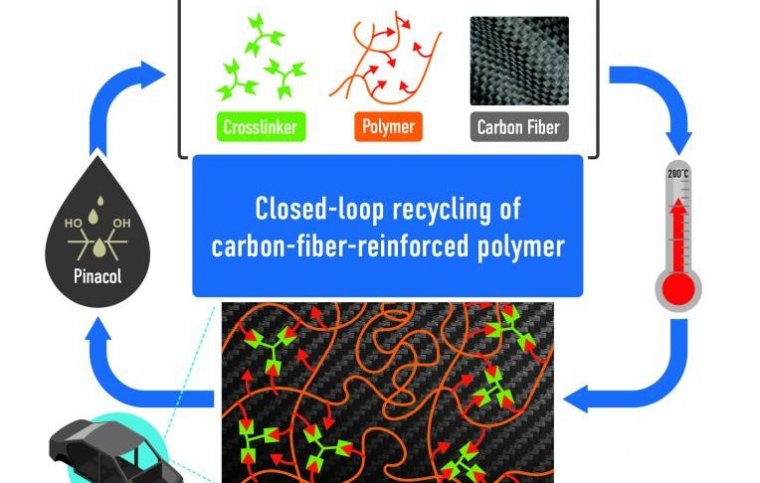| News / Tech News |
New process allows full recovery of starting materials from tough polymer composites
In a win for chemistry, inventors at the Department of Energy’s Oak Ridge National Laboratory have designed a closed-loop path for synthesizing an exceptionally tough carbon-fiber-reinforced polymer, or CFRP, and later recovering all of its starting materials.

A polymer, functionalized carbon fibers and a crosslinker are mixed and cured. The components can be retrieved by addition of an alcohol, pinacol. Credit: Philip Gray and Anisur Rahman/ORNL, U.S. Dept. of Energy
A lightweight, strong and tough composite material, CFRP is useful for reducing weight and increasing fuel efficiency of automobiles, airplanes and spacecraft. However, conventional CFRPs are difficult to recycle. Most have been single-use materials, so their carbon footprint is significant. By contrast, ORNL’s closed-loop technology accelerates addressing that grand challenge.
“We incorporated dynamic crosslinking into a commodity polymer to functionalize it. Then, we added a crosslinker to make it like thermoset materials,” said ORNL chemist and inventor Md Anisur Rahman. “Dynamic crosslinking allows us to break chemical bonds and reprocess or recycle the carbon fiber composite materials.”
A conventional thermoset material is permanently crosslinked. Once synthesized, cured, molded and set into a shape, it cannot be reprocessed. ORNL’s system, on the other hand, adds dynamic chemical groups to the polymer matrix and its embedded carbon fibers.
The polymer matrix and carbon fibers can undergo multiple reprocessing cycles without loss of mechanical properties, such as strength and toughness.
“We invented a tough and recyclable carbon fiber composite,” said ORNL chemist Tomonori Saito. “The fiber and the polymer have a very strong interfacial adhesion due to the presence of dynamic bonds.”
The interface locks materials together through covalent interactions and unlocks them on demand using heat or chemistry. Saito added, “The functionalized fiber has dynamic exchangeable crosslinking with this polymer. The composite structure is really tough because of the interface characteristics. That makes a very, very strong material.”
Conventional polymers like thermoset epoxies are typically used to permanently bond materials such as metal, carbon, concrete, glass, ceramic and plastic to form multicomponent materials such as composites.
However, in the ORNL material, the polymer, carbon fibers and crosslinker, once thermoset, can be reincarnated back into those starting materials.
The material’s components can be released for recycling when a special alcohol called a pinacol replaces the crosslinker’s covalent bonds.
Closed-loop recycling at laboratory scale results in no loss of starting materials. “When we recycle the composites, we recover 100% of the starting materials — the crosslinker, the polymer, the fiber,” Rahman said.
“That’s the importance of our work,” Saito said. “Other composite recycling technologies tend to lose the component starting materials during the recycling process.”
Other advantages of the reversibly crosslinked CFRPs are quick thermosetting, self-adhesive behavior and repair of microcracks in the composite matrix.
In the future, closed-loop recycling of CFRPs may transform low-carbon manufacturing as circular lightweight materials become incorporated into clean-energy technologies.
The researchers drew inspiration from nature, which employs dynamic interfaces to create robust materials. Nacre, the iridescent mother-of-pearl inside the shells of marine mussels and other mollusks, is exceptionally tough: it can deform without breaking.
Moreover, marine mussels strongly adhere to surfaces but dissipate energy to release when necessary.
The researchers aimed to optimize interfacial chemistry between the carbon fibers and the polymer matrix to boost interfacial adhesion and enhance CFRP toughness.
“Our composite’s strength is almost two times higher than a conventional epoxy composite,” Rahman said. “Other mechanical properties are also very good.”
The tensile strength, or the stress a material can bear when it is pulled, was the highest ever reported among similar fiber-reinforced composite materials. It was 731 megapascals — stronger than stainless steel and stronger than a conventional epoxy-based CFRP composite for automobiles.
In the ORNL material, the dynamic covalent bonding between the fiber interface and the polymer had 43% greater interfacial adhesion compared to polymers without dynamic bonds.
The dynamic covalent bonds enable closed-loop recycling. In a conventional matrix material, the carbon fibers are difficult to separate from the polymer. ORNL’s chemical method, which clips fibers at the functional sites, makes it possible to separate fibers from the polymer for reuse.
Karunarathna Koralalage, Rahman and Saito modified a commodity polymer, called S-Bpin, with assistance from Natasha Ghezawi, a graduate student at the Bredesen Center for Interdisciplinary Research and Graduate Education of the University of Tennessee, Knoxville.
They created upcycled styrene ethylene butylene styrene copolymer, which incorporates boronic ester groups that covalently bond with a crosslinker and fibers to generate the tough CFRP.
Because CFRP is a complex material, its detailed characterization required diverse expertise and instrumentation.
Scanning electron microscopy by Bingrui Li, of ORNL and UT, revealed that carbon fiber maintained its quality after recycling. Vivek Chawla and Dayakar Penumadu, both of UT, analyzed interlaminar shear strength. With X-ray photoelectron spectroscopy, ORNL’s Harry Meyer III confirmed what molecules attached to fiber surfaces.
The scientists found that the degree of dynamic crosslinking is important. “We found 5% crosslinking works better than 50%,” Rahman said. “If we increase the crosslinker amount, it starts making the polymer brittle. That’s because our crosslinker has three hand-like bulky structures, able to make more connections and decrease the polymer’s flexibility.” (Oak Ridge National Laboratory)
YOU MAY ALSO LIKE





